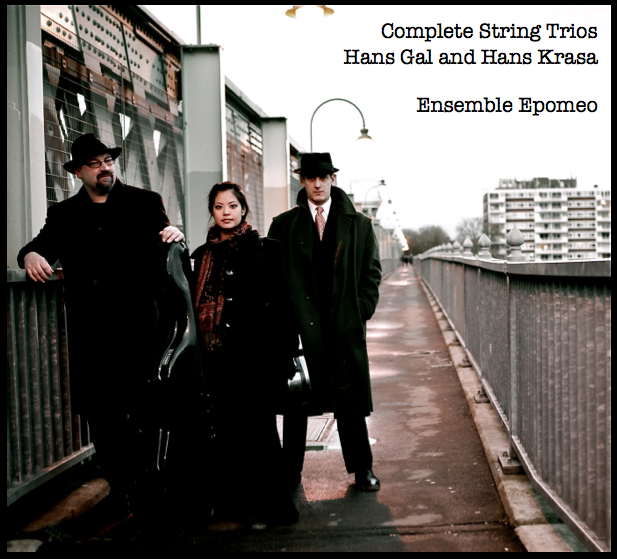Reblogged from Broken Thirds, the Epomeo blog
Hello everyone
We thought it was about time we took a moment to update you on the artistic, rather than financial progress of our CD project.
Our recording of the trios of Hans Gál and Hans Kràsa comes out in September, but our journey with the project is very much on the home straight- the disc goes to the factory this week.
It’s easy to forget that a physical CD is more than just the music- its design also meant to please the eye, and the liner notes should help to illuminate the listening experience. We’re very, very lucky to be releasing this disc on Avie Records, whose model of artist ownership gives musicians every opportunity to shape their message and to make the entire CD, from the notes we play to the liner notes we write, reflect what we’re trying to put across about the music and ourselves.
Not all musicians want to get involved in the minutiae of writing notes, and fewer still have the skill sets to actively participate in the design process, beyond suggesting pictures and giving designers a bit of feedback. Not so in Epomeo- our violist, David Yang, studied architecture and design in a previous life and was very keen to return to dust off his design chops for this project. Everyone in the group and at Avie thought that, because this is our CD debut, the cover needed to introduce us, but also needed to be appropriate for a recording of some music shaped by extremely serious historical events. Most of you will have seen David’s striking design for the CD cover, but we thought some of you might be interested to see the covers we didn’t use:
I think we called this one “French Connection”
I think we called this one “Russian Mob”
I really liked this one:
And my personal favorite
However, there’s more to designing a cover or a whole CD than coming up with a bitchin’ picture and slapping some text on it. CD covers and booklets need to conform to fairly rigid templates, and be encoded in a way that will ensure the colours and proportions end up printed in the right way. White Label Productions do the booklets and design for most of the UK CD industry, including all the Avie recordings, and they’ve worked closely and tirelessly with us in translating David’s designs into something ready to go to the factory. It takes a great deal of patience, attention to detail and an awareness not only of what looks good, but of how people read and take in information.
So, with our factory deadline approaching, we’ve been working to not only get the designs right, but to get the entire booklet finished- notes, bios tracklists and acknowledgements. I (Ken- the cello player) wrote the liner notes back in February and early March, and they’ve since been translated into French and German by White Label’s crack foreign language team. Now that they’ve been formatted into the booklet, I’ve had time to forget what I’ve written and read it with a fresh eye and ear, and, invariably I’ve found a few things that could be improved, and caught one factual error that nobody else had noticed. Of course, there are bound to be typos in all three languages that need to be sniffed out. Nobody catches everything, and usually the author catches the least, so I’m glad I’ve had some great proofreaders to help. I’m amused that I seem to have gotten away with using the expression “all hell breaks loose” in one essay- it’s not typical liner note language for a chamber music disc, but, in this case, all hell does break loose, so unless someone insists on a re-write before tomorrow, I think that will be in there. I’m pleased.
Communication on a project like this can be complicated. Everything needs to be checked and approved by the design team at White Label in London and the senior Avie team in Massachusetts, New York and Oxford. We’ve also been busy sourcing photographs for the booklet from our own photographer, the amazing Benjamin Ealovega and historical images from the Hans Gál Society in Edinburgh, the Jewish Museum in Prague, the US Holocaust Museum and the Wiener Holocaust Memorial Museum in London, all of whom have been incredibly helpful in finding and licencing the images we need to tell the stories of these two composers.
Then there are the three of us in the trio: Ken here in Cardiff, Caroline in Maine for several days and now back in Brooklyn and David, who was in a remote corner of Canada at a chamber music festival for much of the work this month on the booklet, and who is now hard at work in an even more remote corner of Italy. It hasn’t been entirely smooth sailing on the technological front- we’ve had issues with different versions of Acrobat Reader yielding some comically varied versions of the designs on different machines, the hard drive on my MacBook died a few days ago, and David has had to go to some extraordinary lengths to find a WiFi signal in Italy. Here are some of his reports:
-Hi ken,I am sitting out in the middle of the street, if you can believe it, and piggybacking on some unknowing soul’s internet. I was desperate to send this stuff this morning. It really is the middle of nowhere here but strikingly beautiful.
-Here I am in the street again. A stray dog and mangy cat are watching me. They are now my friends.
-The mangy cat just walked away. Got bored, I suspect.
It really is a glamorous life…
So, tomorrow morning, we’ll have a final look at the proofs, and hopefully, we’ll be done with everything but the music.





Recent Comments